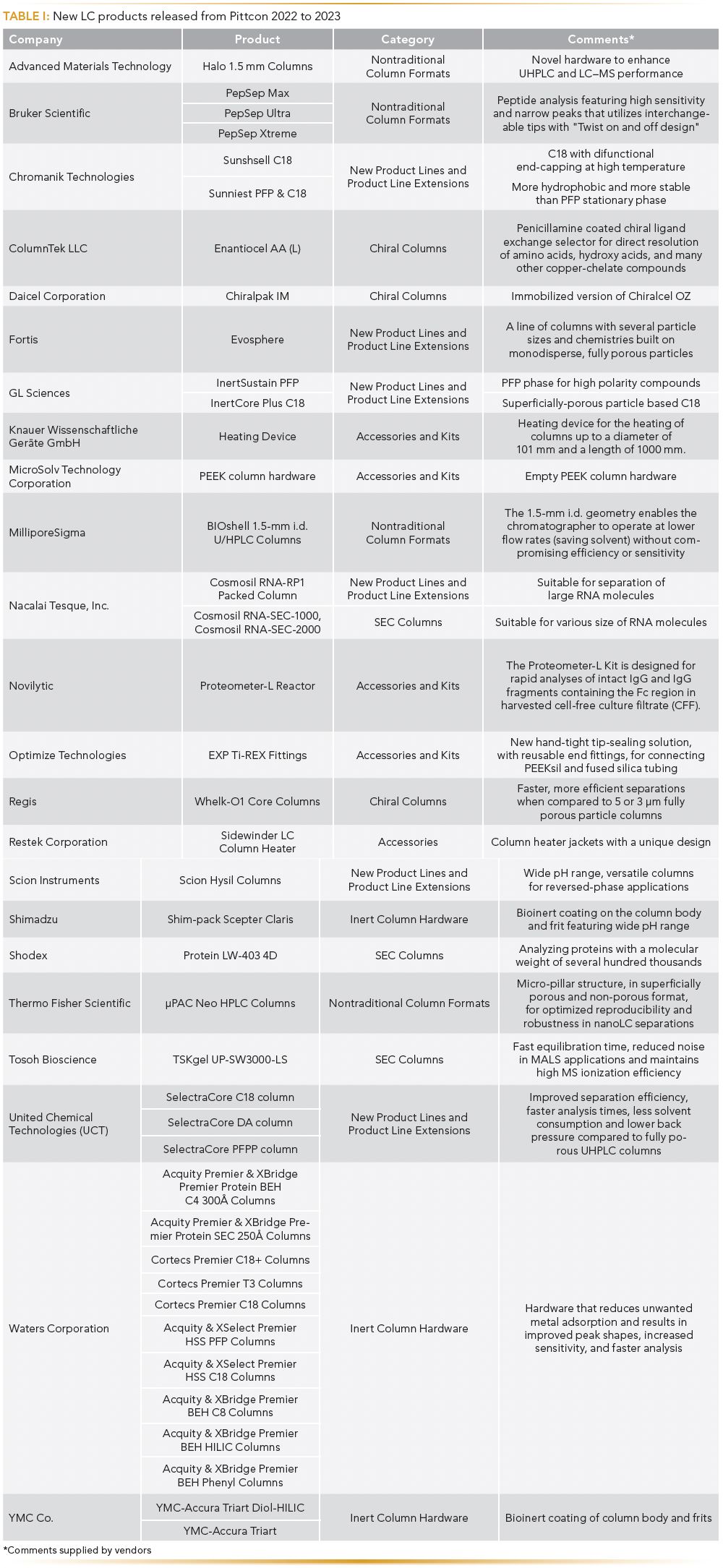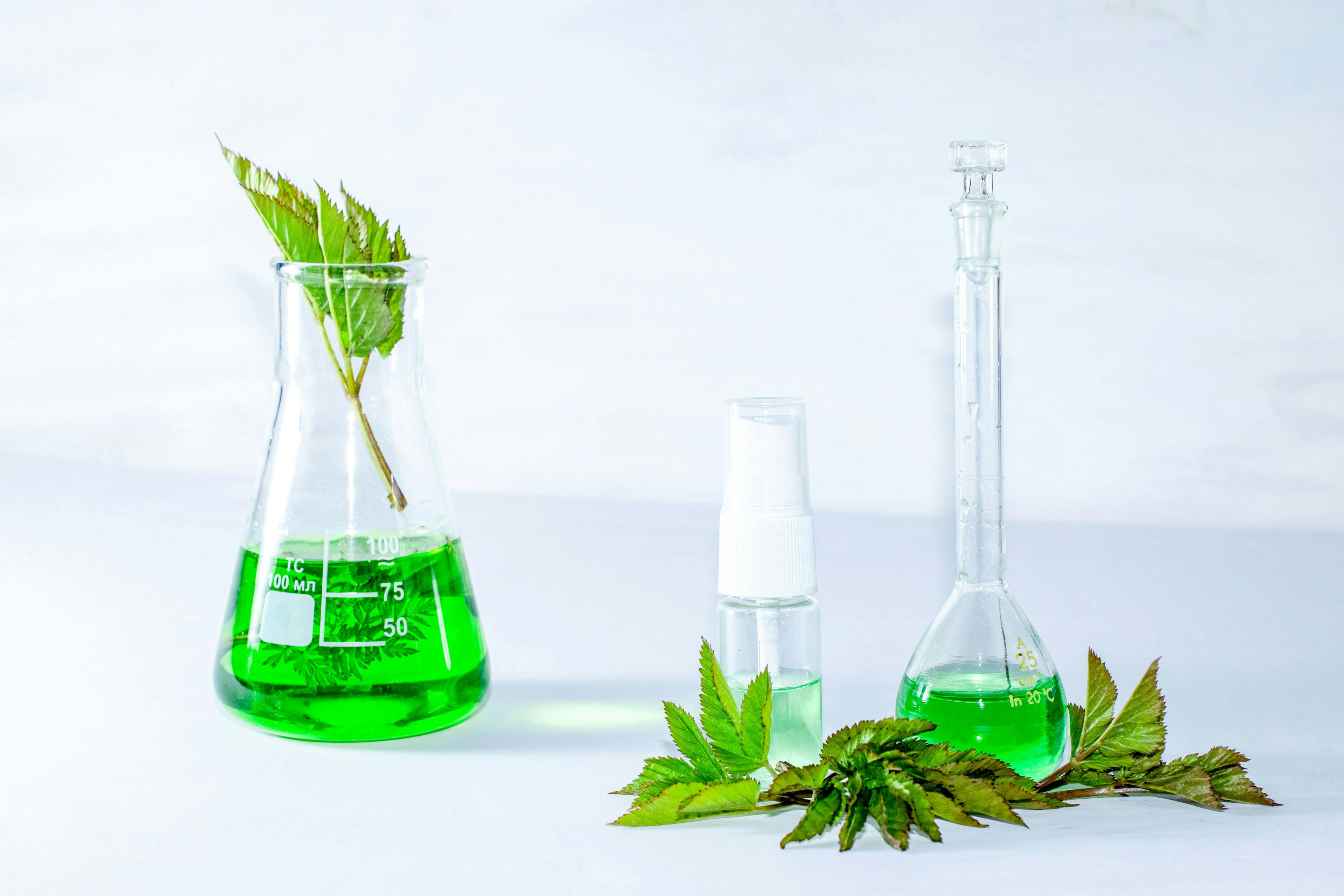New Liquid Chromatography Columns and Accessories: What to Know for 2023
Our annual review of new liquid chromatography columns and accessories, introduced at Pittcon and other events over the past 12 months.
We present our annual review of new liquid chromatography (LC) columns and accessories. This article covers liquid chromatography (LC) columns and accessories commercially released after Pittcon 2022 through the 2023 conference held in Philadelphia. As in the past, LCGC sent out a survey in late 2022 and early 2023 asking vendors to supply information on products launched over the past year. Note that new products for gas chromatography (GC), LC instrumentation and software, and sample preparation are covered elsewhere. Information for this article was obtained over the course of many months; thus, it is possible that some information has been missed or misinterpreted. The reader is encouraged to check with specific vendor sites for additional product releases as well as more detailed information on product usage and attributes. Links to vendor sites are provided where applicable.
The vendors that responded to the survey and their new liquid chromatography (LC) products are listed in Table I. Initial categorization of the products into small and large molecule analyses as done in recent reviews (1–3) was difficult this year because of the number of product line launches that included columns designed for both. The most reasonable segregation this year seemed to be oriented more toward the column technology the product lines were based on rather than their intended use. Many of the products and product lines released this year were based on recent, but established technologies, such as superficially porous particle (SPP) substrates. Many others were extensions of existing product lines with new surface chemistry or bonding processes. Products that fit into these descriptions as well as new chiral and size-exclusion chromatography (SEC) columns were placed in the first category entitled, “New Product Lines and Product Line Extensions.” A second category based on column hardware format was also deemed appropriate. Products in this category that were designated “Nontraditional Column Formats” include the recently introduced 1.5-mm internal diameter (i.d.), capillary, and pillar array columns. The final column-based category includes a number of product lines that have been introduced based on inert column hardware, continuing a major trend from last year (4). Accessories are also an important component to any LC system. That is why the last section is devoted to “non-column” new products that also contribute to successful liquid separations.

New Product Lines and Product Line Extensions
Chromanik Technologies Inc. released two new stationary phases for small molecule analysis. The SunShell C18 is built on a 90 Å, 3.5 μm SPP surface. A “unique end-capping” process using high temperature and hexamethyldichlorotrisiloxane as the end-capping reagent is reported to result in an extended pH range of 1.5–10. The company also launched Sunniest PFP & C18, a mixed pentafluorophenylpropyl and octadecyl phase on a 120 Å, 5-μm fully porous particle (FPP). The mixed phase is more hydrophobic and more stable than the PFP stationary phase alone. More information can be found on the Chromanik website.
Fortis Technologies Ltd. introduced a new line of columns (Evosphere) based on monodisperse, FPP architecture. Monodispersity is reported to “add a new layer efficiency,” while retaining high capacity for increased loading (as in preparative chromatography). According to the company, this is an alternative approach to gaining efficiency compared to using SPP-based phases. The new line is based on a 100 Å pore size that is available in 1.7-, 3-, and 5-μm particle sizes. Numerous surface chemistries are available, including C18 AR (C18 and aromatic mixed bonding), C18/PFP, diphenyl, phenyl-hexyl, AQUA (proprietary polar alkyl blend), C12, RP18-amide, and PFP. For more information see Evosphere on the Fortis Technologies website.
GL Sciences introduced a new SPP-based C18 column branded as InertCore Plus C18. According to the company, the InertCore Plus C18 columns are subjected to rigorous internal quality control (QC), resulting in superior reproducibility because of shell layer homogeneity. More information can be found at the GL Sciences website. The company also launched InertSustain PFP, a column based on 1.9 μm, 100 Å, and FPP architecture. The column is recommended for highly polar molecules.
Nacalai Tesque, Inc. introduced the Cosmosil RNA-RP1 column for the separation of large ribonucleic acid (RNA), messenger RNA (mRNA), and deoxyribonucleic acid (DNA) analytes, a major area of focus for the analytical community over the past few years. The column is based on a 5 μm, “super wide” fully porous silica particle modified with C18. More information can be found at the Nacalai Tesque website.
A new entrant this year, Scion Instruments, released Scion Hysil columns to the market. With both a C8 and C18 surface chemistry, the Hysil phases use a “hybrid” substrate that has a particle size of 5 μm and a 120 Å pore. The company reports a pH range of 1–12 and notes that the columns are versatile for reversed-phase (RP) applications. It is also conveyed that the C18 is compatible with fully aqueous mobile phases. More information can be found on the Scion Instruments website.
United Chemical Technologies released a line of their own SPP-based columns over the past year. The columns are based on a 2.7 μm, 90 Å particle that includes C18, pentafluorophenylpropyl (PFPP; note that the PFP designation may or not include the propyl spacer), and DA surface chemistries. The C18 is noted as being suitable for most acidic, neutral and basic compounds. In addition to reversed-phase applications, the PFPP can be used in both normal phase and HILIC separations and provides excellent retention and selectivity of amine-containing compounds as well as charged bases. The DA phase is described as a proprietary polyaromatic phase suitable for aromatic, conjugated and unsaturated analytes. It is also noted that the DA phase has the ability to analyze compounds that are difficult to resolve on C18. For more information, please refer to the United Chemicals website.
Chiral Columns
ColumnTek, LLC continued to build their portfolio by introducing Enantiocel AA (L). The column is intended for the enantioseparation of amino acids, hydroxy acids, and amino alcohols via a ligand-exchange mechanism using copper ion interaction. This is a silica-based column that has been modified with (L) penicillamine and is available in 3 and 5 μm particle sizes.
Daicel launched the Chiralpak IM column, an immobilized cellulose tris (3-chloro-4-methylphenylcarbamate) based on fully porous silica. The company notes that this is an immobilized version of their Chiralcel OZ phase and that it provides expanded solvent compatibility. The columns, available in both 3 and 5 μm particle sizes, are suitable for SFC, normal phase, reversed-phase and polar organic high performance LC (HPLC) and ultrahigh-pressure LC (UHPLC) modes. For more information, please visit the Daicel website.
Regis Technologies, Inc also introduced a new set of columns over the past year. The Whelk-O1 Core columns are built on a 2.7-μm SPP silica with their Whelk-O1 chiral stationary phase (based on 1-(3,5-dinitrobenzamido)- 1,2,3,4,-tetrahydrophenanthrene), which results in faster and more efficient separations compared to similar conventional fully porous silica columns. It is also notable that the phase is available in both R,R and S,S forms should specific elution order be required. More details may be found at the Regis Technologies website.
SEC Columns
To go with their newly released RP columns for oligonucleotide analyses, Nacalai Tesque Inc. also launched Cosmosil RNA-SEC-1000 and Cosmosil RNA-SEC-2000 for the separation of RNA molecules based on size. The company notes that the 5-μm FPP columns are modified with a “hydrophilic functional group.” For more information on these and related products, please visit the Nacalai Tesque website.
Shodex launched a new SEC column called Protein LW-403 4D. The column is described as a 1.9-μm SPP phase with a hydrophilic surface that is suitable for analyzing proteins with high molecular weight. For additional details, please visit the Shodex website.
Tosoh Bioscience recently commercialized the TSKgel UP-SW3000-LS SEC column. The 2 μm, 250 Å, diol-modified FPP silica-based column is intended for the analysis of biomolecules with size-exclusion chromatography–multiangle light scattering (SEC-MALS) and SEC–mass spectrometry (SEC-MS). The column features fast equilibration times, high robustness, and lot-to-lot reproducibility. Low “shedding” reduces noise in MALS applications. For more information, please visit the Tosoh Bioscience website.
Nontraditional Column Formats
Advanced Materials Technology, Inc. introduced the Halo 1.5 column line of columns for both small molecules, peptides and proteins based on their 2.0- and 2.7-μm SPP technology. The 1.5-mm i.d. columns are reported to provide increased sensitivity from conventional UHPLC systems, higher ionization efficiencies from LC–MS systems, and higher efficiencies compared to 1-mm i.d. columns on UHPLC systems, while reducing solvent consumption (50% compared to 2.1-mm i.d.). According to the company, it is an “easy to implement” microflow solution. The columns are available in multiple surface chemistries for small molecules including C18, LPH (a sterically-protected C18), and AQ-C18 (aqueous compatible C18) in their 90 Å pore size material. For peptides, an ES-C18 chemistry is available in the 160 Å format. A C4 and a diphenyl phase are also available for protein analyses utilizing a 1000 Å pore size. Additional information may be found at the Halo Columns website.
Focusing more on peptide and protein analyses, MilliporeSigma also introduced a line of 1.5-mm i.d. columns under the name BIOshell 1.5-mm i.d. UHPLC columns. The company notes that the 1.5-mm i.d. geometry enables the chromatographer to operate at lower flow rates (saving solvent) without compromising efficiency or sensitivity. The SPP structure, combined with wide pore diameters, enables rapid and high efficiency separations of peptides, monoclonal antibodies (mAbs), bispecific antibodies, and antibody–drug conjugates (ADCs). This line of columns includes C18 (160 Å), C4, and diphenyl (both 1000 Å) surfaces on a 2.7-μm SPP substrate. For additional information, please visit the MilliporeSigma website.
Bruker Scientific LLC developed three new capillary columns geared toward peptide analyses. The columns are based on 1.5 μm, 100 Å fully porous C18 and endcapped particles that differ in dimensions. PepSep Max dimensions are 25 cm (length) x 75 μm (i.d.), whereas the PepSep Ultra and the PepSep Xtreme are 15 cm x 150 μm and 25 cm x 150 μm, respectively. The columns also feature “interchangeable tips,” which reportedly offer robust “twist on and off” connections. More information can be found at the Bruker website.
Thermo Fisher Scientific introduced the μPAC Neo HPLC columns described as micromachined 2.5-μm diameter, C18-modified pillars in a silicon wafer. Columns are available in 50 cm and 110 cm lengths and are intended for nanoLC–MS proteomics. Please visit the Thermo Fisher Scientific website for more information.
Inert Column Hardware
Shimadzu launched a large number of columns under the name Shim-pack Scepter Claris over the past year. The commonalities are a bioinert coating applied to the column body and frits as well as a wide pH range feature. A variety of pore sizes (80, 120, and 300 Å) as well as a number of particle sizes (1.9, 3, and 5 μm) are available. Surface chemistry options include C18, HD-C18 (high density), C4, C8, Diol-HILIC, PFPP, and phenyl. For which phases are available on given supports, please visit the Shimadzu website. The company recommends the columns for analyzing metal-coordinating analytes and hydrophobic compounds such as nucleic acids, proteins, and lipids that adsorb to stainless steel surfaces.
Waters Corporation launched a number of new lines of columns with their metal-passivated column hardware termed MaxPeak High Performance Surface technology. Common to each of these newly branded columns is the Premier designation. Under the Acquity and XBridge Premier BEH banners (hybrid particles 1.7 and 2.5 μm, 130 Å) C8, phenyl and hydrophilic interaction liquid chromatography (HILIC) (bare BEH particles) phases were developed. The C8 is noted as being less retentive than standard C18 phases and exhibiting high pH stability. The phenyl phase provides complementary selectivity to C18 phases, especially for polyaromatic compounds and exhibits the same high pH stability as its C8 kin. The HILIC phase also shows pH stability and is used for highly polar compounds. Under the name Acquity and XSelect Premier HSS columns, both a C18 and a PFP phase were launched. The columns are built on 1.8 and 2.5 μm, 100 Å FPPs with high coverage noted. The C18 exhibits high retention and exceptional peak shapes for bases, whereas the PFP provides alternative selectivity to C18 and separation of closely related compounds with sharp peaks for bases. On the Cortecs Premier line (1.6 and 2.7 μm, 90 Å or 120 Å SPP supports), three chemistries were released, including C18, C18+, and T3. The C18 is described as a “full coverage C18 phase with endcapping,” and it is intended for general use. The C18+ adds a weak anion-exchange character to the C18 that produces excellent peak shapes for bases when using formic acid or other low ionic strength acidic mobile phases. The T3 is noted as a “mid-coverage C18 phase, with endcapping.” The column is recommended for both nonpolar and moderately polar molecules, and it is 100% water-wettable. More details can be found on the Waters website. For large molecules, Waters released the Acquity Premier and XBridge Premier Protein BEH C4 columns. The pH-stable hybrid particle columns are available in 1.7- and 2.5-μm particle sizes with a 300 Å pore size. The C4 surface chemistry, combined with the particle and column technology, results in a column line suitable for intact mass and sub-unit analysis of proteins, including those that are phosphorylated. See the Waters website for additional details.
YMC Co., Ltd. introduced their own line of bioinert columns labeled YMC-Accura Triart. The columns are built on inert hybrid silica particles (1.9, 3, and 5 μm and 120 or 300 Å pore sizes) and packed in hardware (columns and frits) deactivated with a bioinert coating. The columns are noted for their high pH and temperature stability and are recommended for oligonucleotides, (phospho)peptides, (phospho)lipids and other coordinating substances. Stationary phases include C18, C18 ExRS (extended pH and stability), Bio C18, Bio C4, phenyl, PFP, and a diol phase for HILIC separations. For additional information, please visit the YMC website.
Accessories and Kits
Knauer released a new line of column heating devices with varying capacities and features. Two channel systems for heating of the eluent is noted. For further details, please visit the Knauer website.
MicroSolv Technology Corporation introduced a line of polyetheretherketone (PEEK) column hardware. According to the MicroSolv website, their all-PEEK HPLC column hardware is extruded from Victrex PEEK for maximum reproducibility and the finest chromatography. A small amount of graphite (20%) is added to the formulation in order to achieve a black surface sheen. There are no other chemical or physical treatments added to the process making these columns more biocompatible. Columns, frits and end-fittings are available in 2, 4, and 7.5-mm i.d. formats.
Optimize Technologies released EXP Ti-REX fittings, a new hand-tight tip-sealing solution. The reusable fittings are used for connecting PEEKsil and fused silica tubing and are rated to 20,000 psi.
Restek Corporation launched the Sidewinder LC column heater. According to the company, the unique design completely encloses any LC analytical column up to 25 cm in length. Two lengths of heater jackets are available where the short column holder accommodates columns up to 10 cm in length, whereas the long column holder holds columns up to 25 cm in length. The control module provides optimum heating performance (accuracy to within 1 °C) and stability to within 0.1 °C. The Sidewinder controller has fast 10 Hz sampling for improved responsiveness. The RS232 control allows external programming. For additional information, visit the Restek website.
Novilytic developed a new proteomics kit that works with your existing HPLC system. The Proteometer-L kit is designed for rapid analyses of intact IgG and IgG fragments containing the Fc region in a harvested cell-Free culture filtrate (CFF). The kit measures (mAb) titer and relative aggregate content without the need for sample purification. According to the company, the kit offers the following advantages over existing methods for determining mAb titer and aggregate content: two critical quality attributes in one assay as critical quality attributes can be directly analyzed in crude culture filtrate (no additional purification needed), linear response from 0.5–16 mg/mL mAb, very small sample volume is required (minimum 0.5 μL), and fast (10 min) runtime. For more information, please visit the Novilytic website.
Conclusions
Many of the new products and product lines introduced for LC over the past year are either new product line extensions (new chemical surfaces for existing brands) or whole new series based on advanced particle technologies, column hardware developments, or both. Some of the released lines are new to the companies, but they are based on established particle designs (SPP, for example). In another case, a new product line has been launched based on a new monodisperse, fully porous particle. Other new product lines are the result of new or newer technology combinations. For example, there are a few cases where SPP technology and hybrid particle designs are being combined to form improved or alternative column lines. In other products, new column formats are being combined with advanced particle technologies. It is also noted that the trend toward more inert column hardware continues to be significant based on the several collections of columns that have emerged. It is clear that LC vendors continue to put emphasis into new particle and column hardware technologies as well as efforts to best combine these advances to tackle an assortment of separation challenges.
References
(1) Bell, D. S. New Chromatography Columns and Accessories for 2020. LCGC North Am. 2020, 38 (4), 211–219.
(2) Bell, D. S. New Liquid Chromatography Columns and Accessories for 2021. LCGC North Am. 2021, 39 (5), 214–227.
(3) Bell, D. S., New Liquid Chromatography Columns and Accessories for 2022. LCGC North Am. 2022, 40 (5), 210–215. DOI: 10.56530/lcgc.na.sx2967r4
(4) Muraco, C. E.; Bell, D. S. Highlights from the 50th International Symposium on High Performance Liquid Phase Separations and Related Techniques (HPLC 2022). LCGC North Am. 2022, 40 (9), 417–423. DOI: 10.56530/lcgc.na.ws5783s4
ABOUT THE AUTHOR
David S. Bell is a Research Fellow in Research and Development at Restek. He also serves on the Editorial Advisory Board for LCGC and is the Editor for “Column Watch.” Over the past 20 years, he has worked directly in the chromatography industry, focusing his efforts on the design, development, and application of chromatographic stationary phases to advance gas chromatography, liquid chromatography, and related hyphenated techniques. His main objectives have been to create and promote novel separation technologies and to conduct research on molecular interactions that contribute to retention and selectivity in an array of chromatographic processes. His research results have been presented in symposia worldwide, and have resulted in numerous peer-reviewed journal and trade magazine articles. Direct correspondence to: LCGCedit@mmhgroup.com.


Polysorbate Quantification and Degradation Analysis via LC and Charged Aerosol Detection
April 9th 2025Scientists from ThermoFisher Scientific published a review article in the Journal of Chromatography A that provided an overview of HPLC analysis using charged aerosol detection can help with polysorbate quantification.
Removing Double-Stranded RNA Impurities Using Chromatography
April 8th 2025Researchers from Agency for Science, Technology and Research in Singapore recently published a review article exploring how chromatography can be used to remove double-stranded RNA impurities during mRNA therapeutics production.













